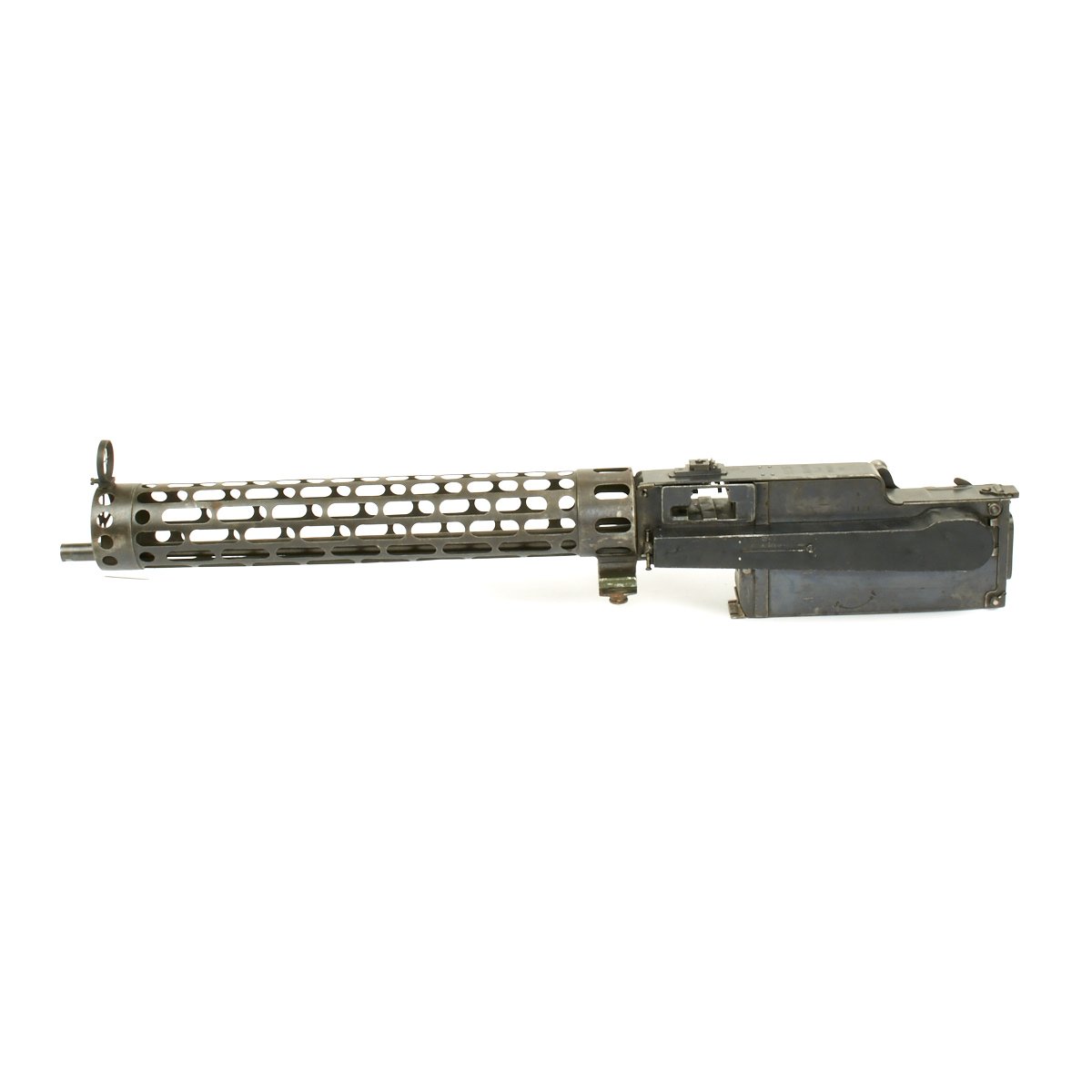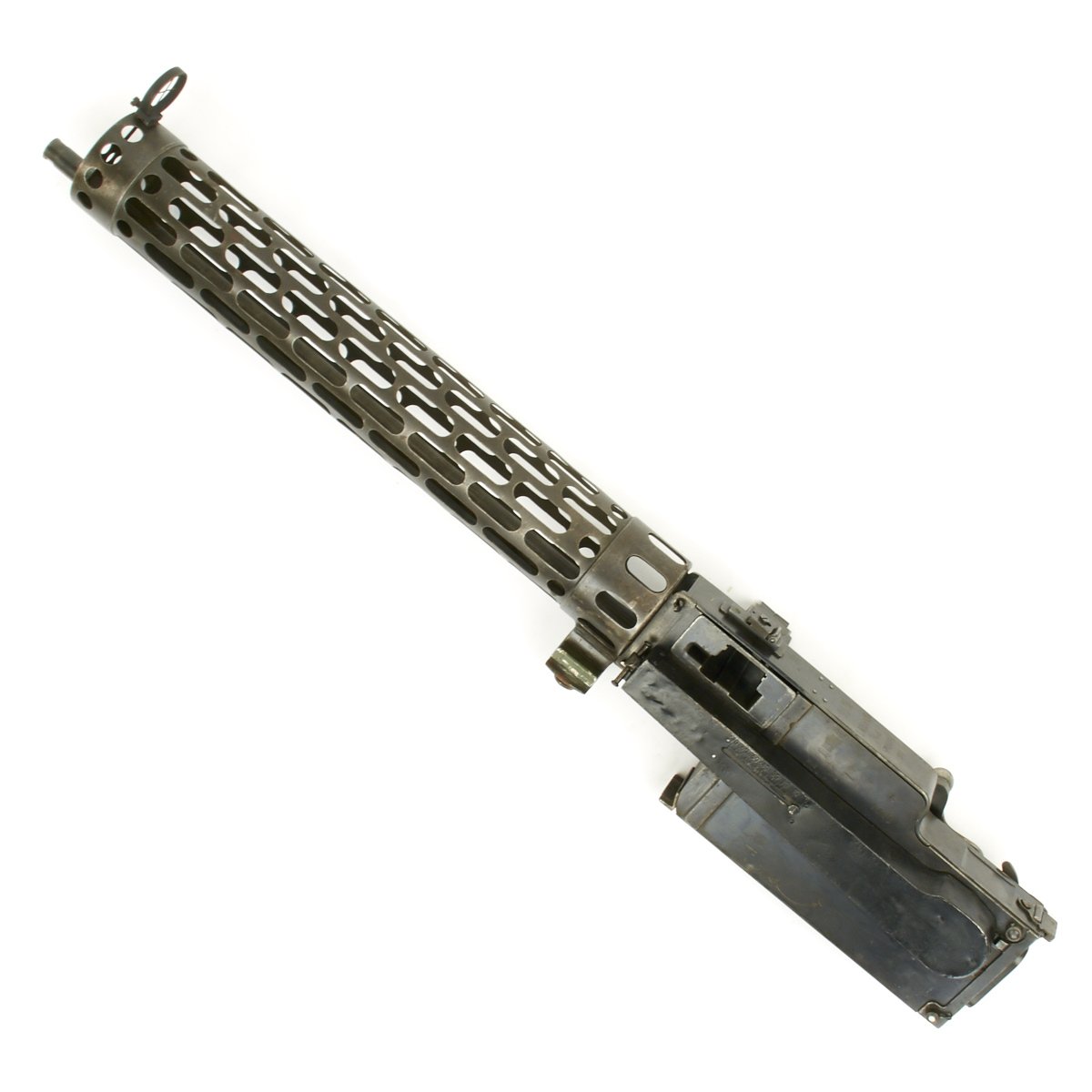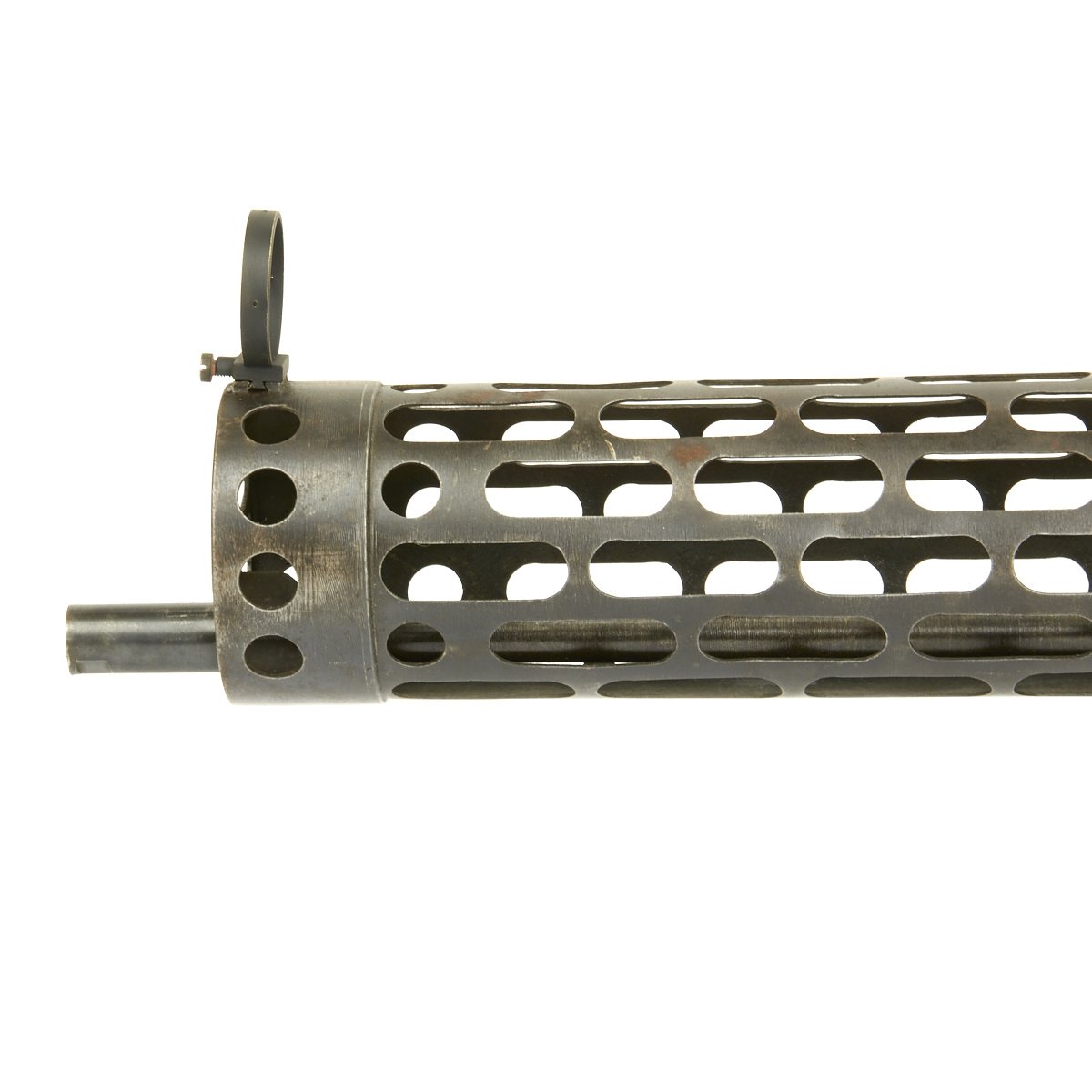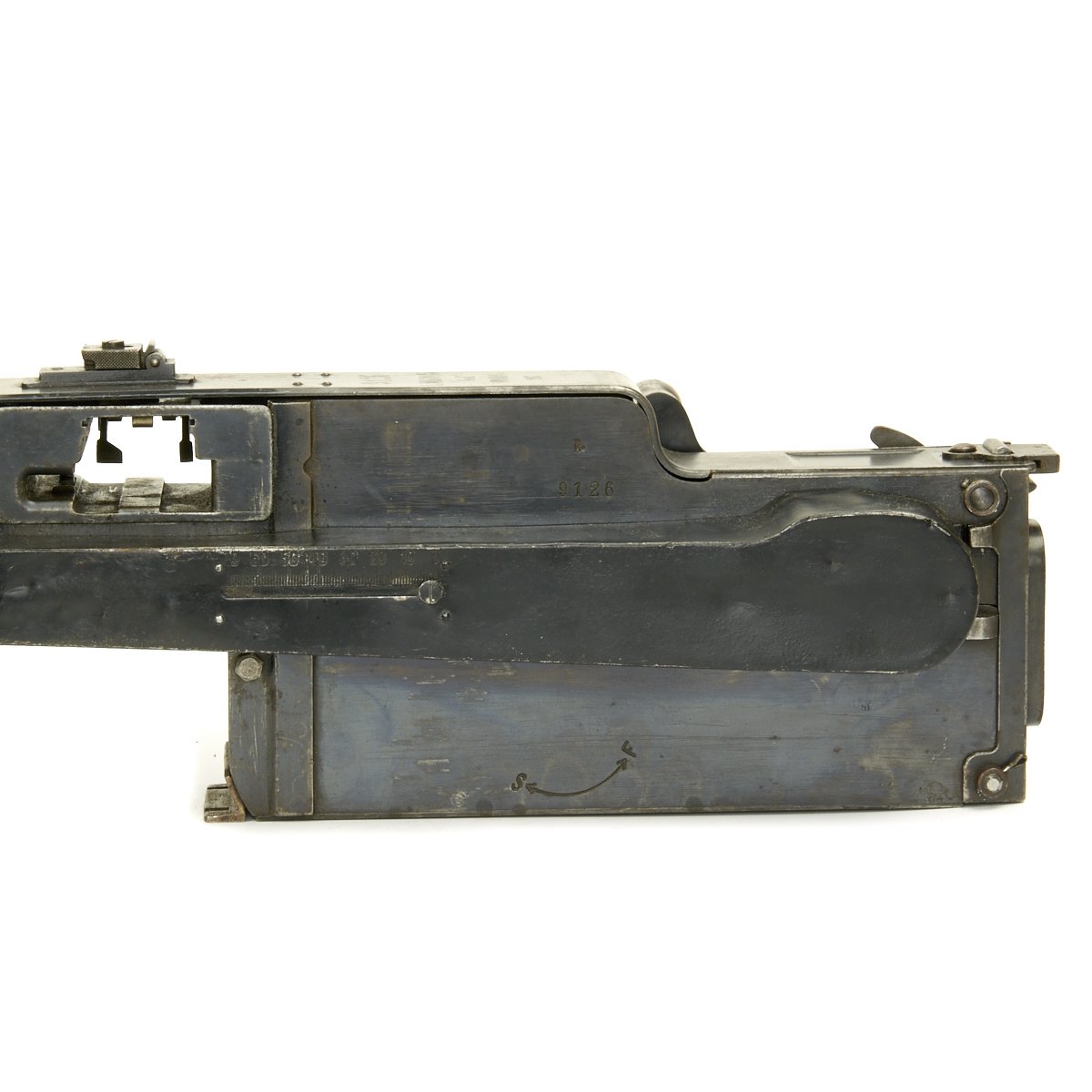Original German WWI Maxim LMG 08/15 Aircraft Display Machine Gun – Spandau 1917 – Partially Matched Serial Numbers Original Items
$ 3.995,00 $ 998,75
Original Item: Only One Available. Only the second lightened air-cooled version LMG 08, developed by the Spandau arsenal as a rigidly mounted aircraft machine gun, that we have ever owned. This fine example of the legendary German WWI Aircraft gun is nicely marked SPANDAU and dated 1917 on the top cover with serial number 9126. The left side plate is also marked 9126, and the shortened number 26 is stamped on many additional parts of the gun. The brass synchronization gear which prevented the rounds from striking the plane’s propeller has unfortunately been removed, though the mounting bracket on the front of the bottom receiver is still present. The mounting trunion was removed, and an adapter for a bipod welded in place, indicating possible use on the ground later in its service life.
Top cover is marked:
9126
L.M.G. 08/15
Gwf.
SPANDAU
1918
This is a complete and fully BATF approved inert non-firing display gun for the advanced collector. This fine example was built from all original parts, with a BATF approved dummy right side plate, and is offered in excellent condition with multiple German markings. Both the rear and front aircraft sights are still present, and the ventilated from barrel jacket is in excellent condition.
History of the LMG 08-
The lightened air-cooled version, the lMG 08, was developed by the Spandau arsenal as a rigidly mounted aircraft machine gun and went into production in 1915, in single-gun mounts, for use on the E.I through the E.III production versions of the Fokker Eindecker. A lower case letter “L” beginning the prefix meant luftgekühlt (air-cooled) rather than Luft (air). The lMG 08s were later used in pairs by the time of the introduction of the Fokker D.III and Albatros D.I biplane fighters in 1916, as fixed and synchronized cowling guns firing through the propeller. The Parabellum MG14 built by DWM was a lighter (22 lbs) and quite different Maxim system gun with a very high rate of fire (900 rounds/min). It was introduced in 1915, and was, but not without serious problems on occasion (as noted by Otto Parschau), prototyped on Parschau’s own A.16/15 Fokker A.III monoplane with the Fokker Stangensteuerung gun synchronizer, received by Parschau on May 30, 1915 and first used in quantity as the synchronized forward-firing armament on the five examples of the Fokker M.5K/MG Eindecker production prototype aircraft, and soon afterwards served as a flexible aircraft observer’s gun for rear defense. The initial model of the air-cooled “Spandau” lMG 08 front-firing cowling machine guns had lost the stocks, grips, and bipods of the infantry MG 08s, but the 103 mm diameter cylindrical sheet metal water jacket was initially over-lightened with cooling slots, and because the cooling jacket on the MG 08 series of guns was an important structural support for the barrel, the excessive slotting of the initial air-cooled lMG 08 rendered the gun as too fragile to the point of making it impossible to fit the muzzle booster that the water-cooled infantry MG 08 guns could be fitted with. The later model of lMG 08 air-cooled machine gun had the slotting omitted at the extreme ends of the cooling jacket’s cylindrical member, with a 13 cm wide area of solid sheet metal at the breech end, and a 5 cm wide solid area at the muzzle end, giving the resultant gun much more rigidity. Also, the lMG 08 retained unchanged the rectangular rear receiver and breech assembly of the water-cooled MG 08 infantry weapon. Later the receiver would be lightened by being “stepped down” at its upper rear and lower forward corners as the more developed and lighter weight LMG 08/15 version was developed, using the same airframe mounting geometry as the earlier ordnance. The lMG 08’s and lMG 08/15’s would always be used as fixed forward-aimed synchronized firing in dual mounts on German single-seat fighter aircraft, first appearing most notably on the mass-produced examples of Robert Thelen’s Albatros D.I and D.II fighters in late 1916, and singly on German armed two-seat observation aircraft for synchronized forward-firing armament. A device, occasionally fitted to the rear surface of the LMG 08/15’s backplate, told the pilot how much ammunition was left to fire, and later on a significant upgrade to the gun’s aerial usability was the fitting of the Klingstrom device on the right side of the receiver, which allowed the gun to be cocked and loaded with one hand from the cockpit. Various cocking/charging handle styles evolved with a simplified distinctive long handled cocking/charging device finally becoming preferred late in the war.
LMG 08/15’s used the 30mm “two hole” ammunition belts of the flexible Parabellum MG14 machine gun rather than the wider “three hole” belts of the MG 08/15 water-cooled infantry weapon. It is possible that these belts were used as they were a bit lighter and less bulky than the wider “three hole” ground gun belts and certainly made for standardization which would have been easier for the armorers and in addition allowed for smaller and lighter “tubes” or “chutes” that guided the empty belts into storage containers in the aircraft after firing. It is a common misconception that the tubes or chutes coming out of the fixed mounted aviation LMG 08/15 fixed guns were for expended cartridge cases; in actuality these attachments were for guiding the empty cartridge belts into a container inside the fuselage of the aircraft so that the belts would not interfere with the operation of the aircraft. As the entire MG 08 Spandau family of German machine guns ejected their empty cartridge cases forward through a round hole in the receiver under the barrel (as can be clearly seen on many videos) these cartridge cases were guided out of the aircraft (except on post Fokker Eindecker Fokker designed aircraft) through tubes from under the barrel to the bottom of the fuselage. With Fokker designed aircraft following the Eindecker the cartridge cases were ejected without tubes from the receiver hole directly into open trays that guided the tumbling cartridge cases backward and sideways onto the sloped fuselage decking which them streamed down past the cockpit on either side. These trays are clearly visible in photographs but have rarely been recognized for their purpose. Hermann Goering, who flew both the Fokker Dr.I and Fokker D.VII was obviously so annoyed with the case tumbling out in front of him that he had deflectors made on his aircraft to ensure the empty cartridge cases did not find their way into his cockpit. On photographs of Goering’s aircraft these plates, only seen on his aircraft, are very prevalent and have even been recognized in scale models of his aircraft copying his particular planes, but even then most historians have failed to recognize their purpose. Both empty belt guides and trays were attached directly to the machine guns rather than to the aircraft. In the famous film showing Australian officers handling the LMG 08/15’s from the crashed Baron von Richthofen’s triplane, the Fokker type belt tubes/chutes and empty cartridge trays can be clearly seen still attached to the guns.
More than 23,000 examples of the LMG 08/15 and an unknown number of the lMG 08 were produced during World War I.
NOTE: Per BATF Ruling 2010-3 a Maxim without a right side plate is not capable of firing, and is not considered a firearm of any type.
Fast Shipping with Professional Packaging
Thanks to our longstanding association with UPS FedEx DHL, and other major international carriers, we are able to provide a range of shipping options. Our warehouse staff is expertly trained and will wrap your products according to our exact and precise specifications. Prior to shipping, your goods will be thoroughly examined and securely secured. We ship to thousands clients each day across multiple countries. This shows how we're dedicated to be the largest retailer on the internet. Warehouses and distribution centres can be located throughout Europe as well as the USA.
Note: Orders with more than one item will be assigned a processing date depending on the item.
Before shipping before shipping, we'll conduct a thorough inspection of the items you have ordered. Today, the majority of orders will be delivered within 48 hours. The delivery time will be between 3-7 days.
Returns
The stock is dynamic and we cannot completely manage it because multiple stakeholders are involved, including our factory and warehouse. So the actual stock may alter at any time. It's possible that you may not receive your order once the order has been made.
Our policy is valid for a period of 30 days. If you don't receive the product within 30 days, we are not able to issue a refund or an exchange.
You can only return an item if it is unused and in the same state as the day you received it. You must have the item in its original packaging.
Related products
Uncategorized
Uncategorized
Uncategorized
Armored Burgonet Helmet & Polearm from Scottish Castle Leith Hall Circa 1700 Original Items
Uncategorized
Uncategorized
Uncategorized
Uncategorized
Uncategorized
Uncategorized
Uncategorized
Uncategorized
Uncategorized
Uncategorized
Uncategorized
Uncategorized
Uncategorized
Australian WWII Owen MK1 Machine Carbine SMG Custom Fabricated Replica with Sling Original Items
Uncategorized













































































